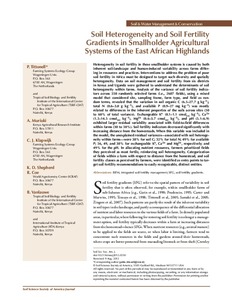| dc.contributor.author | Tittonell, Pablo A. |
| dc.contributor.author | Muriuki, A. |
| dc.contributor.author | Klapwijk, C.J. |
| dc.contributor.author | Shepherd, Keith D. |
| dc.contributor.author | Coe, R. |
| dc.contributor.author | Vanlauwe, Bernard |
| dc.date.accessioned | 2019-12-04T10:57:04Z |
| dc.date.available | 2019-12-04T10:57:04Z |
| dc.date.issued | 2013 |
| dc.identifier.citation | Tittonell, P., Muriuki, A., Klapwijk, C.J., Shepherd, K.D., Coe, R., Vanlauw, B. (2013). B. Soil Heterogeneity and Soil Fertility Gradients in Smallholder Agricultural Systems of the East African Highlands. Sol Sci Soc Am J. doi:10.2136/sssaj2012.0250. |
| dc.identifier.uri | https://hdl.handle.net/20.500.12478/575 |
| dc.description.abstract | Heterogeneity in soil fertility in these smallholder systems is caused by both inherent soil-landscape and human-induced variability across farms differing in resources and practices. Interventions to address the problem of poor soil fertility in Africa must be designed to target such diversity and spatially heterogeneity. Data on soil management and soil fertility from six districts in Kenya and Uganda were gathered to understand the determinants of soil heterogeneity within farms. Analysis of the variance of soil fertility indicators across 250 randomly selected farms (i.e., 2607 fields), using a mixed model that considered site, sampling frame, farm type, and field as random terms, revealed that the variation in soil organic C (6.5?27.7 g kg?1), total N (0.6?3.0 g kg?1), and available P (0.9?27 mg kg?1) was mostly related to differences in the inherent properties of the soils across sites (50 to 60% of total variance). Exchangeable K+ (0.1?1.1 cmol(+) kg?1), Ca2+ (1.5?14.5 cmol(+) kg?1), Mg2+ (0.6?3.7 cmol(+) kg?1), and pH (5.1?6.9) exhibited larger residual variability associated with field-to-field differences within farms (30 to 50%). Soil fertility indicators decreased significantly with increasing distance from the homesteads. When this variable was included in the model, the unexplained residual variances?associated with soil heterogeneity within farms?were 38% for soil C; 32% for total N; 49% for available P; 56, 49, and 38% for exchangeable K+, Ca2+ and Mg2+, respectively; and 49% for the pH. In allocating nutrient resources, farmers prioritized fields they perceived as most fertile, reinforcing soil heterogeneity. Categorization of fields within a farm with respect to distance from the homestead, and soil fertility classes as perceived by farmers, were identified as entry points to target soil fertility recommendations to easily recognizable, distinct entities. |
| dc.language.iso | en |
| dc.publisher | Soil Science Society of America Journal |
| dc.title | Soil Heterogeneity and Soil Fertility Gradients in Smallholder Agricultural Systems of the East African Highlands |
| dc.type | Journal Article |
| cg.contributor.crp | Water, Land and Ecosystems |
| cg.coverage.region | Africa |
| cg.coverage.region | East Africa |
| cg.coverage.country | Kenya |
| cg.coverage.country | Uganda |
| cg.identifier.url | https://www.soils.org/publications/sssaj/abstracts/77/2/525 |
| cg.journal | Soil Science Society of America Journal |
| cg.accessibilitystatus | Limited Access |
| local.dspaceid | 35728 |

